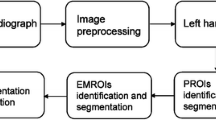Abstract
Segmentation of anatomical structures in radiological images is one of the important steps in the computerized approach to the bone age assessment. In this paper a method dealing with correct location of the borders in the epi-metaphyseal regions of interest is described. The well segmented bone structures are obtained utilizing the Gibbs random fields as the first segmentation step; however this method does not prove to be adequate in the correct outline of other tissues in the epi-metaphyseal area. In order to correct delineation of cartilage in this region, the second segmentation step utilizing the active contours serving as a post-segmentation edge location technique is applied. Controlling of tension and bending of the active contour requires a set of weights in the energy functional to be set. To adjust the weights and to initially test the methodology a model of region of interest containing three different anatomical structures corrupted with Gaussian noise has been designed. Combined methodology of Gibbs random fields and active contours with the final set of weights was applied to 200 regions of interest randomly selected from 1100 left hand radiographs. A meaningful improvement in terms of ultimate contour location and smoothing has been observed in regions with cartilage or bone convexity developed near the bottom region of the epiphysis.







Similar content being viewed by others
References
Greulich WW, Pyle SI (1971) Radiographic atlas of skeletal development of hand wrist, 2nd edn. Stanford University Press, Stanford
Tanner JM, Whitehouse RH (1975) Assessment of skeletal maturity and prediction of adult height (TW2 method). Academic, London
Piętka E, Gertych A, Pośpiech S, Huang HK, Cao F (2001) Computer assisted bone age assessment: image pre-processing and ROI extraction. IEEE Trans Med Imaging 20:715–729
Piętka E, Pośpiech S, Gertych A, Cao F, Huang HK, Gilsanz V (2001) Computer automated approach to the extraction of epiphyseal regions in hand radiographs. J Digit Imaging 14:165–172
Piętka E, Pośpiech-Kurkowska S, Gertych A, Cao F (2003) Integration of computer assisted bone age assessment with clinical PACS. Comput Med Imging Graph 27: 217–228
Lee JS (1981) Refined filtering of image noise using local statistics. Comput Vis Graph Image Process 15:380–389
PappasT (1992) An adaptive clustering algorithm for image segmentation. IEEE Trans Signal Process 40:901–914
Immerkaer I (1996) Fast noise variance estimation. Comput Vis Image Underst 64:300–302
Besag J (1986) On the statistical analysis of dirty pictures. J R Stat Soc B 48:259–302
Kass M, Witkin A, Terzopoulos D (1988) Snakes: active contour models. Int J Comput Vis 1:321–331
Terzopoulos D, Fleisher K (1988) Deformable models. Vis Comput 4:306–331
Sonka M, Hlavac V, Boyle R (1998) Image processing analysis and machine vision, 2nd edn. Thomson Learning Vocational Publishing, Florence 84:374
Williams DJ, Shah M (1992) A fast algorithm for active contours and curvature estimation, CVGIP. Image Underst 55:14–26
MacQueen JB (1967) Some methods for classification and analysis of multivariate observations. In: Proceedings of 5th Berkley symposium on mathematical statistics and probability. University of California, Berkley 1:281–297
Piętka E, Gertych A, Witko K (2005) Informatics infrastructure of CAD system, Comput Med Imaging Graph 29:157–169
Author information
Authors and Affiliations
Corresponding author
Rights and permissions
About this article
Cite this article
Gertych, A., Piętka, E. & Liu, B.J. Segmentation of regions of interest and post-segmentation edge location improvement in computer-aided bone age assessment. Pattern Anal Applic 10, 115–123 (2007). https://doi.org/10.1007/s10044-006-0056-4
Received:
Accepted:
Published:
Issue Date:
DOI: https://doi.org/10.1007/s10044-006-0056-4




